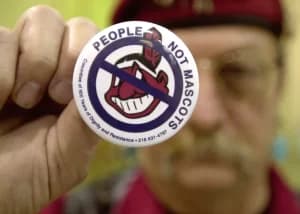More than 3,000 participants attend Minneapolis event

Powwow attendee Sonny Hensley holds an anti-mascot button to protest using Indians as mascots for sports teams at the 2003 New Years Eve Sobriety Powwow in Columbus, Ohio. Mike Simons/Getty Images
What comes to mind when you think about your favorite sports team or fast-food restaurant? Ronald McDonald, Colonel Sanders, Benny the Bull, the San Diego Chicken? I’m sure all of these ring a bell – even the logos of the teams and companies you love play a vital role in recognition. Unfortunately, many mascots today are still stereotyping Native culture.
The idea of a team mascot began in the 1800s when a little boy carried bats and ran errands for a team of baseball players – Chic quickly became known as the team’s good luck charm. Since then, the idea of a mascot has grown and plays a vital role in reflecting the identity of the community in which a sports team resides. Think about the local college or high school sports teams – what mascots do you see?
In 1968, the National Congress of American Indians, NCAI, launched its campaign to address stereotypes of Native people in popular culture, media, and sports, with significant progress made in the pursuit of ending the era of “Indian” mascots. Since 2021, NCAI has expanded its initiative to include work at the state level, engaging directly with state legislatures to pursue mascot bans through legislation – focusing on the K-12 school level, state level, and professional sports level.
In 2001, the New York State Commissioner for Education issued a memorandum to schools to retire their Native American mascots, team names, and logos – and while some complied with the memorandum, many schools did not and still have these mascots, names, and logos today. In fact, NCAI reports show that close to 2000 schools nationwide still use Native American mascots, team names, and logos.
In a memo dated November 17, 2022, James N. Baldwin, the New York Senior Deputy Commissioner for Education, said, “Schools are learning environments; students learn as much through observation of their surroundings as they do from direct instruction.” Now, schools across New York state must comply by the end of the school year or risk losing state aid. The only caveat made is for schools and districts that obtain the approval and permission of a specific tribe.
Earlier this year, another school district came under fire when a TikTok post went viral showing two students dressed up as an Indian chief and maiden performing a ceremony with a pipe and performing a dance before a basketball game. Anderson Community School Corporation in Anderson, Indiana, has used its Native roots as the basis for its logo and mascot, with permission of the ancestors of Chief William Anderson, leader of the Unalatchgo Lenape tribe from 1806 to 1831 – for which the town is named after. After the TikTok video went viral, the tradition came under scrutiny, to which Superintendent Joseph Cronk confessed that the tradition has always been done to honor the city’s Native American heritage and that maybe there was some ignorance involved.
“Maybe we don’t know what we’re honoring. Maybe we’re not honoring at all.”
Superintendent Joseph Cronk, Fox59
The final decision was delivered after a school board meeting in June 2022 – with Anderson Community Schools halting the tradition of having the students dress up and perform before events. The school, however, will keep the “Indians” nickname, logo, and signage.
Over the years, several North Dakota schools, including the University of North Dakota, have changed their nicknames and logos to stop the stereotyping associated with using Native culture as a mascot. A few schools within the state still use “Sioux” and “Braves” in their names, but many are defunct due to changes in the school system or the mascot name – confirmed using MascotDB with a localized search for North Dakota and visiting school websites.
The position of the NCAI is clear, longstanding, and deeply rooted as a voice for Indian Country. The continued efforts of their advocacy are transforming how Native culture is portrayed – protecting civil rights, social justice, and racial equity of Native people in all parts of American society.
Jodi Rave Spotted Bear (Mandan, Hidatsa and Arikara Nation)
Founder & Editor in Chief
Location: Twin Buttes, North Dakota
Spoken Languages: English
Topic Expertise: Federal trust relationship with American Indians; Indigenous issues ranging from spirituality and environment to education and land rights
See the journalist page“New York tells schools to drop Native American mascots,” NPR, Giulia Heyward, November 19, 2022, https://www.npr.org/2022/11/19/1137904447/native-american-mascots-new-york-schools
National School Mascot Tracking Database: The Current Numbers, NCAI, November 15, 2022, https://www.ncai.org/NCAI_School_Mascot_Tracking_Database_-_Overview_and_Numbers.pdf
“Re: Use of Native American Mascots,” November 17, 2022, https://www.nysed.gov/common/nysed/files/programs/main/indigenous-native-american-mascot-memo.pdf
“Schools urged to stop using Indian names,” James C. McKinley, Jr., New York Times, April 6, 2001, https://www.nytimes.com/2001/04/06/nyregion/schools-urged-to-stop-using-indian-names.html
North Dakota Mascots, MascotDB, https://www.mascotdb.com/states/north-dakota
“Viral TikTok leads to review of Anderson’s Indian mascot,” Max Lewis, Fox59, April 17, 2022, https://fox59.com/indiana-news/viral-tiktok-leads-to-review-of-andersons-indian-mascot/
“Mascots,” Jeff Marzick, The Culture Crush, https://www.theculturecrush.com/feature/mascots
“Ending the Era of Harmful ‘Indian’ Mascots,” NCAI, https://www.ncai.org/proudtobe
“Anderson schools removes students dressed as ‘Indian’ mascot and performance, keeps logo,” MJ Slaby, IndyStar, June 16, 2022, https://www.indystar.com/story/news/education/2022/06/16/anderson-schools-indiana-mascot-performance-no-more-indigenous-peoples/7651741001/
© Buffalo's Fire. All rights reserved.
This article is not included in our Story Share & Care selection.The content may only be reproduced with permission from the Indigenous Media Freedom Alliance. Please see our content sharing guidelines.
Youth Night creates safe space for newcomers to the arena
Honor Yellow Bird Woman with fulfillment of Cobell Settlement terms
Missing persons searches use drones, sonar and scent tracking dogs







